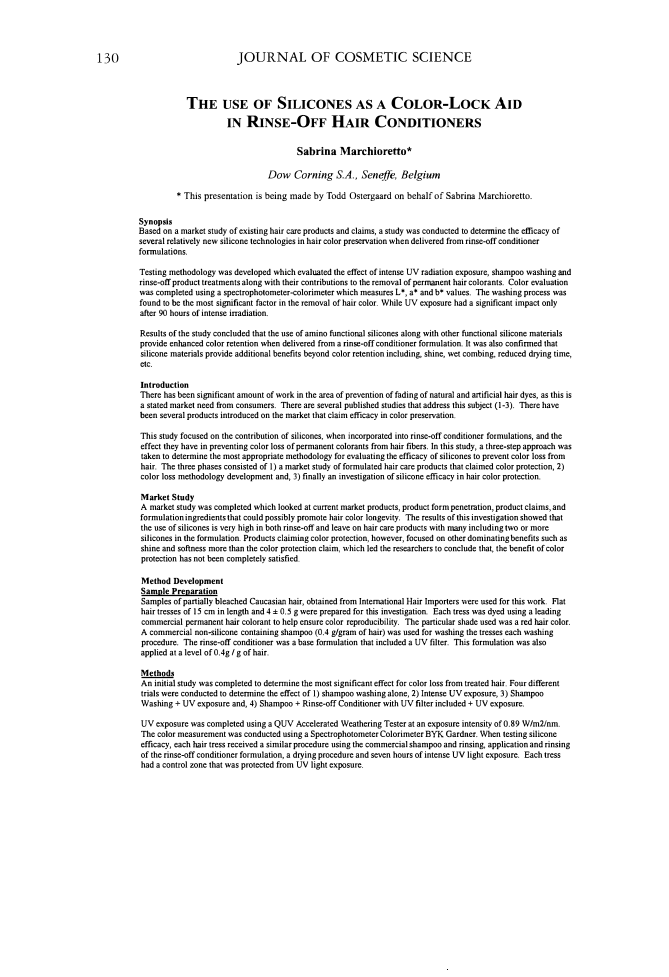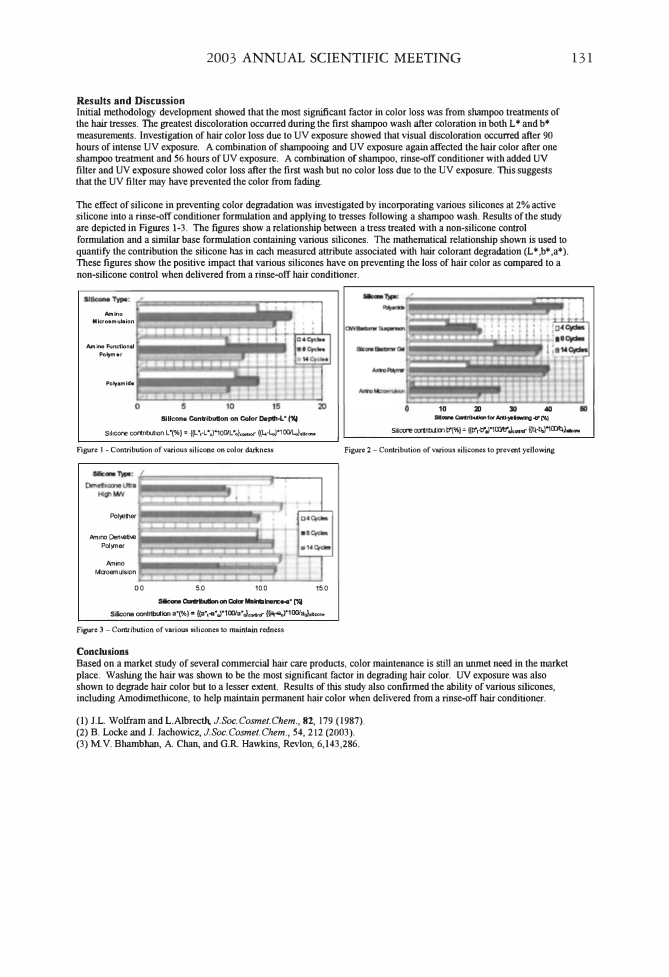130 JOURNAL OF COSMETIC SCIENCE THE USE OF SILICONES AS A COLOR-LOCK Arn IN RINSE-OFF HAIR CONDITIONERS Sabrina Marchioretto* Dow Corning S.A., Senejfe, Belgium * This presentation is being made by Todd Ostergaard on behalf of Sabrina Marchioretto. Synopsis Based on a market study of existing hair care products and claims, a study was conducted to determine the efficacy of several relatively new silicone technologies in hair color preservation when delivered from rinse-off conditioner formulations. Testing methodology was developed which evaluated the effect of intense UV radiation exposure, shampoo washing and rinse-off product treatments along with their contributions to the removal of permanent hair colorants. Color evaluation was completed using a spectrophotometer-colorimeter which measures L *, a* and b* values. The washing process was found to be the most significant factor in the removal of hair color. While UV exposure had a significant impact only after 90 hours of intense irradiation. Results of the study concluded that the use of amino functional silicones along with other functional silicone materials provide enhanced color retention when delivered from a rinse-off conditioner formulation. It was also confirmed that silicone materials provide additional benefits beyond color retention including, shine, wet combing, reduced drying time, etc. Introduction There has been significant amount of work in the area of prevention of fading of natural and artificial hair dyes, as this is a stated market need from consumers. There are several published studies that address this subject (1-3 ). There have been several products introduced on the market that claim efficacy in color preservation. This study focused on the contribution of silicones, when incorporated into rinse-off conditioner formulations, and the effect they have in preventing color Joss of permanent colorants from hair fibers. In this study, a three-step approach was taken to determine the most appropriate methodology for evaluating the efficacy of silicones to prevent color loss from hair. The three phases consisted of I) a market study of formulated hair care products that claimed color protection, 2) color loss methodology development and, 3) finally an investigation of silicone efficacy in hair color protection. Market Study A market study was completed which looked at current market products, product form penetration, product claims, and formulation ingredients that could possibly promote hair color longevity. The results of this investigation showed that the use of silicones is very high in both rinse-off and leave on hair care products with many including two or more silicones in the formulation. Products claiming color protection, however, focused on other dominating benefits such as shine and softness more than the color protection claim, which Jed the researchers to conclude that, the benefit of color protection has not been completely satisfied. Method Development Sample Preparation Samples of partially bleached Caucasian hair, obtained from International Hair Importers were used for this work. Flat hair tresses of 15 cm in length and 4 ± 0. 5 g were prepared for this investigation. Each tress was dyed using a leading commercial permanent hair colorant to help ensure color reproducibility. The particular shade used was a red hair color. A commercial non-silicone containing shampoo (0.4 g/gram of hair) was used for washing the tresses each washing procedure. The rinse-off conditioner was a base formulation that included a UV filter. This formulation was also applied at a level of 0.4g / g of hair. Methods An initial study was completed to determine the most significant effect for color Joss from treated hair. Four different trials were conducted to determine the effect of I) shampoo washing alone, 2) Intense UV exposure, 3) Shampoo Washing+ UV exposure and, 4) Shampoo + Rinse-off Conditioner with UV filter included+ UV exposure. UV exposure was completed using a QUV Accelerated Weathering Tester at an exposure intensity of0.89 W/m2/nm. The color measurement was conducted using a Spectrophotometer Colorimeter BYK Gardner. When testing silicone efficacy, each hair tress received a similar procedure using the commercial shampoo and rinsing, application and rinsing of the rinse-off conditioner formulation, a drying procedure and seven hours of intense UV light exposure. Each tress had a control zone that was protected from UV light exposure.
2003 ANNUAL SCIENTIFIC MEETING Results and Discussion Initial methodology development showed that the most significant factor in color loss was from shampoo treatments of the hair tresses. The greatest discoloration occurred during the first shampoo wash after coloration in both L * and b* measurements. Investigation of hair color loss due to UV exposure showed that visual discoloration occurred after 90 hours of intense UV exposure. A combination of shampooing and UV exposure again affected the hair color after one shampoo treatment and 56 hours of UV exposure. A combination of shampoo, rinse-off conditioner with added UV filter and UV exposure showed color loss after the first wash but no color loss due to the UV exposure. This suggests that the UV filter may have prevented the color from fading. The effect of silicone in preventing color degradation was investigated by incorporating various silicones at 2% active silicone into a rinse-off conditioner formulation and applying to tresses following a shampoo wash. Results of the study are depicted in Figures l-3. The figures show a relationship between a tress treated with a non-silicone control formulation and a similar base formulation containing various silicones. The mathematical relationship shown is used to quantify the contribution the silicone has in each measured attribute associated with hair colorant degradation (L * ,b* ,a*). These figures show the positive impact that various silicones have on preventing the Joss of hair color as compared to a non-silicone control when delivered from a rinse-off hair conditioner. Amino M lcroem ulaion Amino Functional Polymer Potyamide 10 2D 30 40 SIDoono Catrlb.Clonlcr Antl-;tU-lng -II'(%) 131 SIiicone Contribution on Color Depth-l * (0/ s,I,cone contribution L*(%) = {(L*,-L*0)*100/L*0},on1,o1· ((L.·L.)*100/L.}, """" Silicae cortnb.tio. tr(%)= ((trrtr .)"1cntr J,ar,.,.. {(q-t\,)"1mt.}-., Figure 1 - Contribution of various silicone on coloc darkness Poli,ether .amino Deriseti-.e Pol)!Tler .Amino Mcroernulsion 00 5.0 10.0 Silicone 0:Jnlrlbullon 011 Coler Malnlalnen:e-e• r.,,. 15.0 Silicone contribution a*(%)= {(a"re*.)*100/a*J,.......- {(a,-a,,)*100/aJ,mcono Fi gu re 3 - Contribution of various silicones to maintain redness Conclusions Figure 2 - Contribution of various silicones to prevent yellowing Based on a market study of several commercial hair care products, color maintenance is still an wimet need in the market place. Washing the hair was shown to be the most significant factor in degrading hair color. UV exposure was also shown to degrade hair color but to a lesser extent. Results of this study also confirmed the ability of various silicones, including Amodimethicone, to help maintain permanent hair color when delivered from a rinse-off hair conditioner. (1) J.L. Wolfram and L.Albrecth, J.Soc.Cosmet.Chem., 82, 179 (1987). (2) B. Locke and J. Jachowicz, J.Soc.Cosmet.Chem., 54, 212 (2003). (3) M.V. Bhambhan, A. Chan, and G.R. Hawkins, Revlon, 6,143,286.
Purchased for the exclusive use of nofirst nolast (unknown) From: SCC Media Library & Resource Center (library.scconline.org)





































































































































